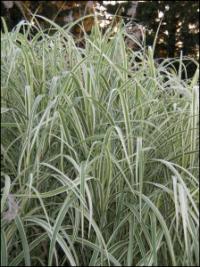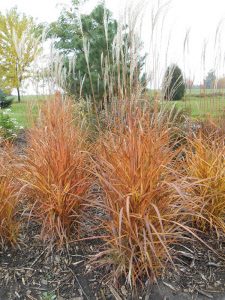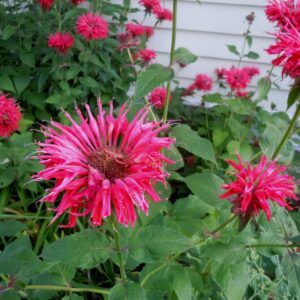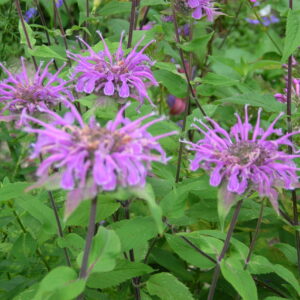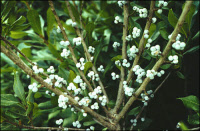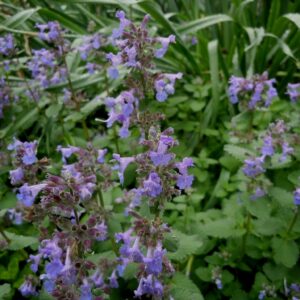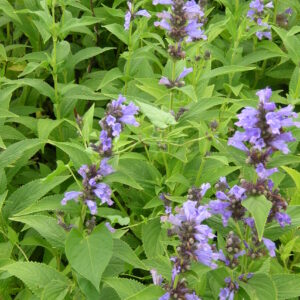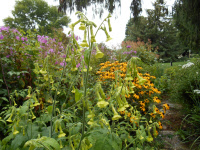Our Plants
Showing 385–392 of 587 results
-
Miscanthus sinensis ‘Variegatus’ Striped Maiden grass Z 4-
Vertical white srtipes on 4' arching green grass blades, inflorescenses coppery russet in fall,
Vertical white srtipes on 4′ arching green grass blades, inflorescenses coppery russet in fall
Size: 6' x 4' clump forming
Care: Sun moist well-drained soil. Cut back in spring.
Native: S.E. AsiaMiscanthus is Greek meaning stem and flower. Mentioned in Man’yoshu, a Japanese anthology of poems written in the 8th century, where it symbolized the melancholy of autumn. This variegated form frequently used in Victorian bedding designs. American garden cultivation since late 1800’s. Recommended by Gertrude Jekyll, mother of mixed perennial borders, in 1908, for its “great white striped” foliage.
-
Miscanthus sinensis subsp. purpurascens syn. Miscanthus ‘Purpurascens’ Flame grass Z 4-9
Flame grass starts in spring tinged with red in the leaves, increasing as summer passes. By fall the leaves turn brilliant orange-red, darkening to burgundy by winter. It retains its color for a few months. Tassel-like inflorescences appear in late summer, opening into creamy plumes by fall. It is upright and clump-forming.
Flame grass starts in spring tinged with red in the leaves, increasing as summer passes. By fall the leaves turn brilliant orange-red, darkening to burgundy by winter. It retains its color for a few months. Tassel-like inflorescences appear in late summer, opening into creamy plumes by fall. It is upright and clump-forming.
Size: 4-5’ x 3-4’
Care: sun to part shade in any soil - sandy to clay soils. Cut back in late winter to spring.
Native: Japan
Wildlife Value: Deer resistant and tolerant of Walnut trees.Miscanthus is Greek meaning stem (“miskos) and flower (“anthos”). Miscanthus mentioned in Man’yoshu, a Japanese anthology of poems written in the 8th century, where it symbolized the melancholy of autumn. This specific plant described by Swedish botanist Nils Johan Andersson (1821-1880) in 1855 in Öfvers. Kongl. Vetensk.-Akad. Förh. 12:167.
-
Monarda didyma ‘Cambridge Scarlet’ Beebalm Z 4-9
Whorls of scarlet tubes & bracts looking like fireworks, in summer
Whorls of scarlet tubes & bracts looking like fireworks, in summer
Size: 3-4' x spreading
Care: sun to part shade in well-drained soil.
Native: N. E. America
Wildlife Value: Checkered white, Fritillary and Melissa blue butterflies relish Beebalm’s nectar.Cherokee used the species medicinally, to cure colic, flatulence, nosebleed, measles, flu, hysteria and to induce restful sleep. Monarda was named in honor of Nicholas Monardes (1493-1588), a Spanish botanist who wrote about plants of the New World. Discovered by John Bartram (1699-1777) being used by colonists in Oswego N.Y. to make tea. Oswego Indians taught the colonists how to make tea from the dried leaves. Bartram sent this Beebalm to Peter Collinson in England in whose garden it grew in 1744. By 1757 its English availability was “nearly universal” among gardeners. During the American Revolution used as a substitute for tea. Grown at America’s 1st botanic garden, Elgin Botanic Garden 1811.This cultivar ‘Cambridge Scarlet’ recommended by Gertrude Jekyll in 1908.
-
Monarda fistulosa Wild bergamont Z 3-9
Whorls of hooded lavender tubes in July - August
Whorls of hooded lavender tubes in July – August
Size: 3-4' x 2' spreading
Care: Sun to part shade any soil.
Native: central U.S., Wisconsin native
Wildlife Value: Checkered white, Tiger swallowtail, Giant swallowtail and Melissa blue butterflies relish Wild bergamot’s nectar. Supports over 70 bee species including Rusty patched Bumble Bee.Used medicinally by many Native tribes- Blackfoot, Cherokee, Chippewa, Choctaw, Crow, Dakota and Flathead. Cherokee: to cure colic, flatulence, nosebleed, measles, flu, hysteria and to induce restful sleep Blackfoot called it “Single-young-Man.” Teton Dakotas boiled the leaves and flowers for medicine to cure abdominal pain. Ho-Chunk boiled the leaves to make a medicine for pimples. Choctaws cured chest pain in children. The Flathead cured colds and sore teeth with Wild Bergamot. HoChunk inhaled fumes in a sweat bath to cure colds. Oneidas made a tea. For the Sioux it was nourishment and a panacea: tea, stomachache, fever, indigestion, sore throats, fainting, whooping cough, wounds, sore eyes, ulcers, and snakebites. First documented by French explorers before 1635. Plant exported to Europe by Tradescant the Younger in 1637. Grown by Washington at Mount Vernon. Today it is a flavor in Earl Grey tea.
-
Myrica pensylvanica syn. Morella pensylvanica Wax myrtle, Northern bayberry SHRUB Z 3-6
Green flowers in summer then, “conspicuous in winter when covered with its grayish white fruits which stay on the branches until spring.” Bailey “The leaves turn a fine brown-purple in the fall, but the berries are the thing – pewter in color, with a texture like those Fourth of July sparklers of childhood memory, they have a delicious fragrance.” Allen Lacy.
OUT OF STOCK
Green flowers in summer then, “conspicuous in winter when covered with its grayish white fruits which stay on the branches until spring.” Bailey “The leaves turn a fine brown-purple in the fall, but the berries are the thing – pewter in color, with a texture like those Fourth of July sparklers of childhood memory, they have a delicious fragrance.” Allen Lacy.
Size: 9’ x 10’
Care: sun in any soil
Native: Canada to Southeastern U.S. No pruning needed but can be pruned at any time of year, if desired.
Wildlife Value: Berries relished by chickadees, red-bellied woodpeckers, swallows, Titmouse, catbirds, bluebirds, Northern flicker & yellow-rumped warblers. Bayberry thickets also provide nesting sites for songbirds, offering excellent protection from predators.Probably 1st collected for gardens by John Bartram (1699-1776). Offered for sale in Bartram Garden’s 1783 Broadside, America’s 1st plant catalog. In 1800’s considered “very ornamental in the shrubbery.” Fragrant leaves used for potpourri, abundant berries used to make candles. Good road-side plant, salt tolerant. Berries used to make candles. Boil berries (drupes) to melt wax coating. Collect wax from surface of water. In American Medicinal Plants Charles F. Millspaugh noted that “Candles made from this wax, though quite brittle, are less greasy in warm weather, of fine appearance, slightly aromatic, and smokeless after snuffing, rendering them much more pleasant to use than those made of either wax (paraffin) or tallow (animal fat).” 1892.
-
Nepeta racemosa syn. N. mussinii Catmint Z 4-8
Lavender blue from May through September, cut back for rebloom
Lavender blue from May through September, cut back for rebloom
Size: 18" x 18"
Care: Full sun in well-drained soil
Native: Caucasus
Wildlife Value: attracts butterflies and bees
Awards: Royal Horticultural Society Award of Merit.Nepetas may have been named after Nepete, an old Etrusrian city. Mussinii named for the plant’s discoverer, Russian Count Apollos Apollosovitch Mussin-Pushkin. In gardens before 1810 and a favorite Victorian bedding plant by the late 1800’s. Catmints contain various amounts of an essential oil (nepetalactone) both a cat stimulant and a mosquito repellant.
-
Nepeta subsessilis Japanese catmint Z 4-8
Showy bluish-purple spikes of bell-shaped flowers forming short spikes, June-September
Showy bluish-purple spikes of bell-shaped flowers forming short spikes, June-September
Size: 18-24” x 18-24”
Care: sun to part shade in moist to moist well-drained soil
Native: Japan
Wildlife Value: deer & rabbit resistant, attracts butterfliesSubsessilis means nearly without stalks. Catmints contain various amounts of an essential oil (nepetalactone) both a cat stimulant and a mosquito repellant. From Nambu Japan where botanists called it Miso-gawa- sô. Von Siebold, German botanist and physician, who worked in Japan from 1823 to1830, saw it. Named in Bull. Acad. Imp. Sci. Saint-Pétersburg, sér. 3, 20: 469. (1875) by Russian botanist Karl Maximowicz.
z.
-
Nicotiana langsdorffii Langsdorff’s tobacco Z 10-11, grow as annual in colder areas
Pendulous Granny Smith apple colored, tube-shaped flowers in summer through fall.
Pendulous Granny Smith apple colored, tube-shaped flowers, in summer through fall.
Size: 2-3’ x 6”
Care: full sun to part shade in well-drained soil
Native: Chile and Brazil
Wildlife Value: attract hummingbirds
Awards: England’s Royal Horticultural Society Award of Merit.Nicotiana langsdorfii introduced in 1819. The genus name nicotiana named after John Nicot who introduced smoking tobacco to Europe. Langsdorfii named to honor Russian naturalist Georg Heinrich von Langsdorff, Baron de Langsdorff ( 1774 -1852), Russian consul general in Brazil and leader of Langsdorff Expedition of Brazil, 1826-1829.

